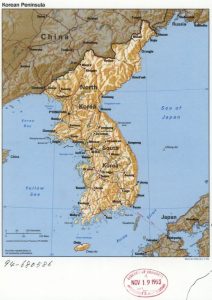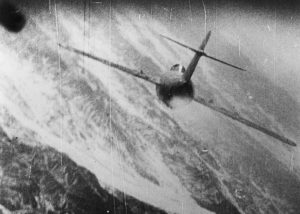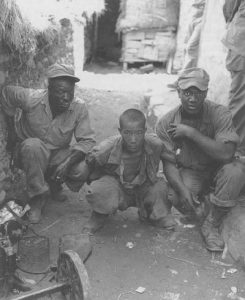
This year marks the 65th anniversary of the start of one of the key events of the early Cold War: the Korean War. The conflict began on June 25, 1950, when communist North Korea invaded pro-western South Korea. Bolstered by a United Nations Security Council resolution, the US led a multinational intervention that beat back the North Korean invasion, then pushed on into North Korea itself. In November, 1950, communist China intervened to save North Korea from defeat, pushing the US-led forces back into South Korea and recapturing the South Korean capital of Seoul. An American counteroffensive in early 1951 liberated Seoul from the communists, and the war soon settled into a bloody stalemate running roughly contiguous to the 38th parallel. After two more years of fighting and negotiations, an armistice was signed on July 27, 1953, bringing an end to the major fighting.
The Korean War exacted a horrific human toll, claiming some 2,000,000 lives, including over 36,000 Americans. Politically, it further intensified the already burgeoning US-Soviet confrontation. For the first time since the end of World War II, the West and the Communist Bloc engaged in direct armed conflict. Seventeen nations contributed combat forces to the UN coalition, including the United States and South Korea. Within the US, the Korean War intensified fears of a broader war with the USSR, as well as worries over the American Communist Party, and gave further impetus to internal security measures directed at real or alleged acts of subversion.
While North Korea and Communist China were the main participants on the communist side of the war, the Soviet Union was far more involved than has often been realized. Kim IL-Sung, North Korea’s communist dictator and grandfather of current North Korean ruler Kim Jong-Un, had to obtain the permission of Soviet dictator Josef Stalin before launching his invasion, which Stalin finally granted in February 1950. The North Korean army was Soviet trained, Soviet equipped, and the plans for the invasion were drawn up by Soviet generals. While the USSR was officially not involved in hostilities, Stalin, in fact, committed a force of up to 200 Soviet aircraft, most famously the MiG-15 jet fighter, to provide air cover over parts of North Korea and northeast China, an area that would become famous as “MiG Alley.” Soviet pilots saw their first action in November 1950, and regularly engaged American and other aircraft in combat.
Technically, in the absence of a peace treaty, the Korean War has never ended, and the peninsula remains divided by a heavily fortified Demilitarized Zone. Tensions and hostility between North Korea, now nuclear armed, and South Korea, pose one of the main threats to international peace and stability.
The following is a very selective bibliography of CWIS and other federal documents relevant to the Korean War, both primary sources from the time, as well as secondary historical monographs. This represents just a portion of available sources in Joyner Library on this topic.

Korean War Era Documents in the CWIS Collection:
Communist Persecution of Churches in Red China and Northern Korea: Consultation with Five Church Leaders: Rev. Peter Chu Pong, Rev. Shih-Ping Wang, Rev. Tsin-Tsai Liu, Rev. Samuel W.S. Cheng, Mr. Kyung Rai Kim. Committee on Un-American Activities, House of Representatives, Eighty-Sixth Congress, First Session. 1959. (Joyner Docs CWIS: Y 4.UN 1/2:C 47)
Franciszek Jarecki: Flight to Freedom. Hearing Before the Committee on Un-American Activities, House of Representatives, Eighty-Third Congress, First Session. 1953. (Joyner Docs CWIS: Y 4.UN 1/2:J 28; also available in Joyner Docs Stacks: Y 4.UN 1/2:J 28)
-Jarecki, a Polish MiG-15 pilot who defected by flying his plane to Denmark, testified that his Soviet instructors had flown combat missions in Korea, testimony lent substantial credence by post-Cold War archival revelations.
International Communism (Communist Encroachment in the Far East) : Consultation with Maj. Gen. Claire Lee Chennault, United States Army. Committee on Un-American Activities, House of Representatives, Eighty-Fifth Congress, Second Session. 1958. (Joyner Docs CWIS:Y 4.UN 1/2:C 73/94)
International Communism, Red China and the Far East (testimony of Chiu-Yuan Hu). Hearing Before the Committee on Un-American Activities, House of Representatives, Eighty-Fifth Congress, First Session. 1957. (Joyner Docs CWIS: Y 4.UN 1/2:C 73/75; also available in Joyner Docs Stacks: Y 4.UN 1/2:C 73/75)
Investigation of Communist Propaganda among Prisoners of War in Korea (Save Our Sons Committee). Hearings Before the Committee on Un-American Activities, House of Representatives, Eighty-Fourth Congress, Second Session. 1956. (Joyner Docs CWIS: Y 4.UN 1/2:C 73/6; also available in Joyner Docs Stacks: Y 4.UN 1/2:C 73/6)
Korean War Atrocities. Hearing Before the Subcommittee on Korean War Atrocities of the Permanent Subcommittee on Investigations of the Committee on Government Operations, United States Senate, Eighty-Third Congress, First Session. 3 v., 1953. (Joyner Docs CWIS: Y 4.G 74/6:K 84/)
Military Situation in the Far East. Hearings Before the Committee on Armed Services and the Committee on Foreign Relations, United States Senate, Eighty-Second Congress, First Session, to conduct an inquiry into the military situation in the Far East and the facts surrounding the relief of General of the Army MacArthur from his assignments in that area, 5 v., 1949. (Joyner Docs CWIS: Y 4.AR 5/3:M 59/7/Pt. 1 and Pts. 3-5; Pt. 2 is missing)
Who Are They?: Prepared at the Request of the Committee on Un-American Activities: Part 6: Kim Il Sung and Ho Chi Minh (North Korea–North Viet-Nam.) Library of Congress. Legislative Reference Service, 1957. (Joyner Docs CWIS: Y 4.UN 1/2:W 62/PT. 6)

Other Korean War Federal Documents:
Ammunition Shortages in the Armed Forces. Hearings Before the Preparedness Subcommittee No. 2 of the Committee on Armed Services, United States Senate, Eighty-Third Congress, First Session. 1953. (Joyner Docs Stacks: Y 4. Ar 5/3: Am 6/2/1953)
Bowers, William T. Black Soldier, White Army: the 24th Infantry Regiment in Korea. Washington, DC: Center of Military History, U.S. Army, 1996. (Joyner Docs Stacks: D 114.2:B 56)
Endicott, Judy G. The USAF in Korea: Campaigns, Units, and Stations, 1950-1953. Washington, DC: Air Force History and Museums Program, 2001. (Joyner Docs Stacks: D 301.82/7:K 84/6)
MiG Alley: Sabre vs. MiG. National Museum of the U.S. Air Force, 2015. (Available online at: http://www.nationalmuseum.af.mil/Visit/MuseumExhibits/FactSheets/Display/tabid/509/Article/196385/mig-alley-sabre-vs-mig.aspx)
Mossman, Billy C. Ebb and Flow, November 1950-July 1951. Washington, DC: Center of Military History, U.S. Army, 1990. (Joyner Docs Stacks: D114.2 K84/5)
Return of American Prisoners of War Who have not been Accounted for by the Communists: Hearing Before the Subcommittee on the Far East and the Pacific of the Committee on Foreign Affairs, House of Representatives, Eighty-Fifth Congress, First Session. 1957. (Joyner Docs Stacks: Y 4.F 76/1:P 93)
Smith, Charles R. U.S. Marines in the Korean War. Washington, DC: History Division, U.S. Marine Corps, 2007. (Joyner Docs Stacks: D 214.13:K 84/14)
U.S. Army Center of Military History: Korean War.
-Offers the full-text of digitized Army historical monographs and other resources.
Y’Blood, William T. Mig Alley: The Fight for Air Superiority. Washington, DC: Air Force History and Museums Program, 2000. (Joyner Docs Stacks: D 301.82/7:M 58; also available online at: http://www.afhso.af.mil/shared/media/document/AFD-100928-020.pdf)
Related Readings:
Fehrenbach, T. R.. This Kind of War. New York: Macmillan, 1963. (Joyner Stacks: DS918 .F37)
Jager, Sheila Miyoshi. Brothers at War: The Unending Conflict in Korea. New York: W. W. Norton & Company, 2013. (Joyner Library Order on Demand via Library Catalog)
Jian, Chen. China’s Road to the Korean War: the Making of the Sino-American Confrontation. New York: Columbia University Press, 1994. (Joyner Stacks: DS919.5 .C4513 1994)
Joiner, Stephen. ‘The Jet that Shocked the West: How the MiG-15 grounded the U.S. bomber fleet in Korea.‘ Air & Space Magazine, December 2013.
Sheng, Michael M. Battling Western Imperialism: Mao, Stalin, and the United States. Princeton, NJ: Princeton University Press, 1997. (Joyner Stacks: DS740.5.S65 S562 1997)
Werrell, Kenneth P. Sabres over MiG Alley: The F-86 and the Battle for Air Superiority in Korea. Annapolis, MD: Naval Institute Press, 2005. (Joyner Stacks: DS920.2.U5 W47 2005)
Wilson Center Digital Archive: ‘Korean War, 1950-1953.”
-“A collection of primary source documents related to the Korean War. Obtained largely from Russian archives, the documents include reports on Chinese and Soviet aid to North Korea, allegations that America used biological weapons, and the armistice.”
Xiaoming, Zhang. ‘China, the Soviet Union, and the Korean War: From an Abortive Air War Plan to a Wartime Relationship.‘ The Journal of Conflict Studies 22 (1), Spring 2002.